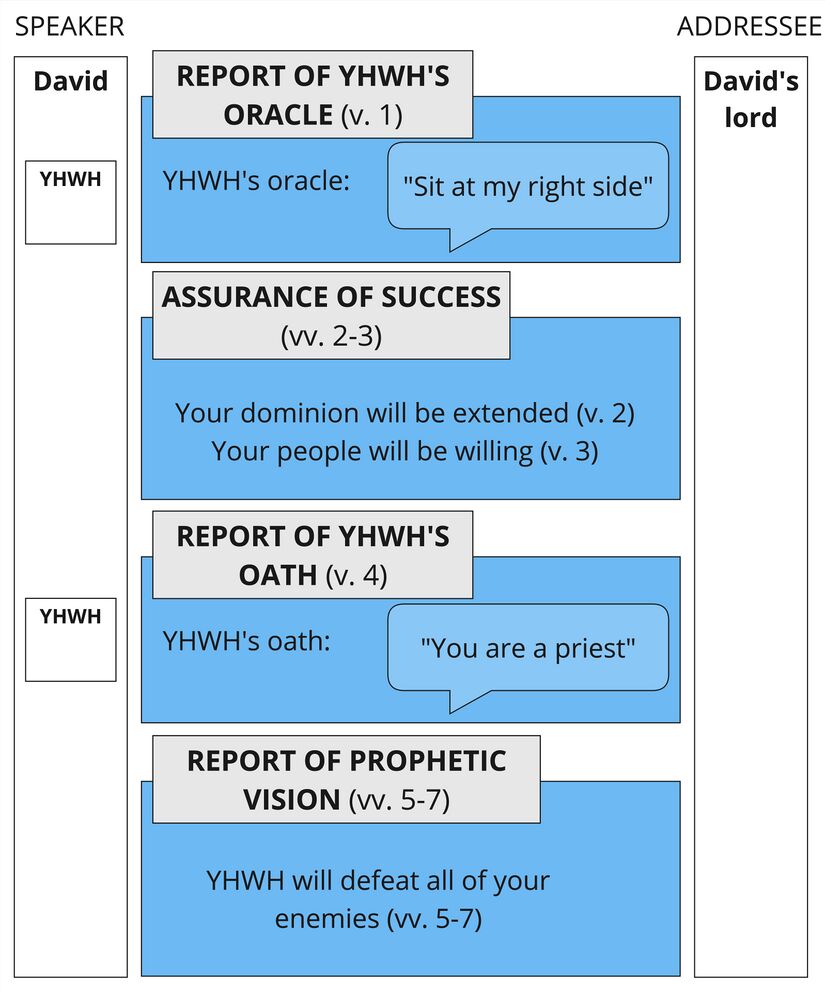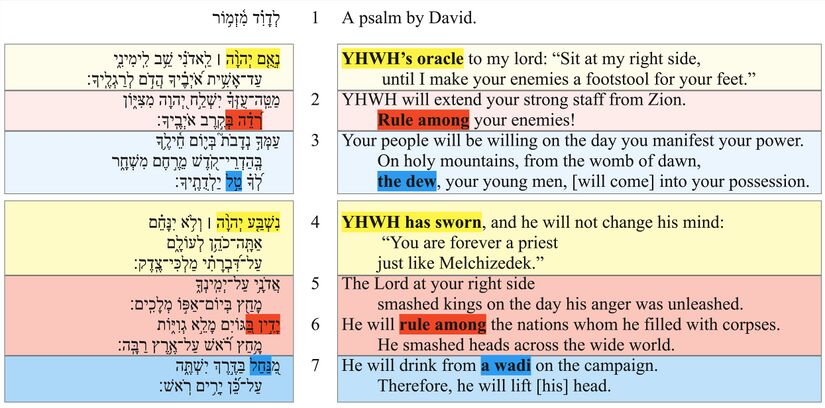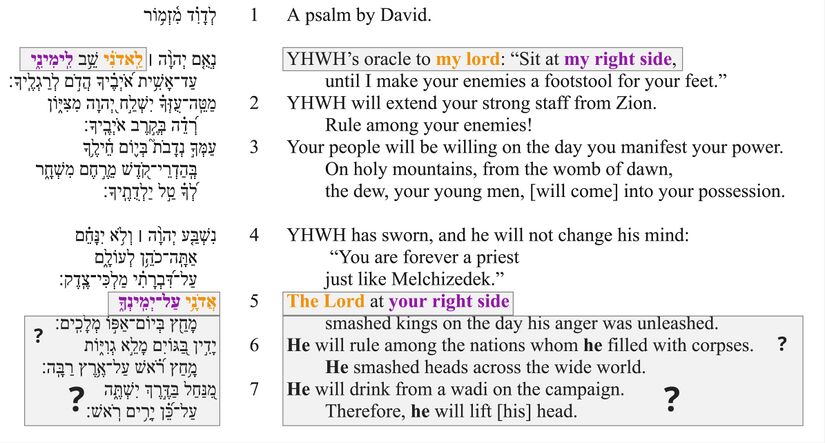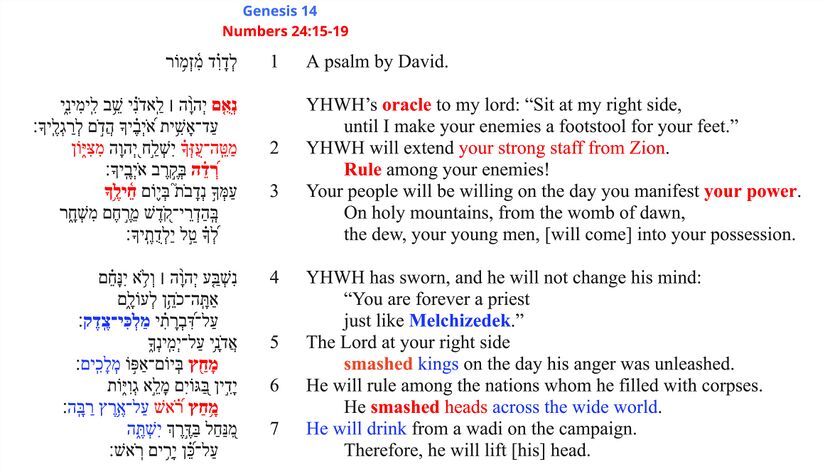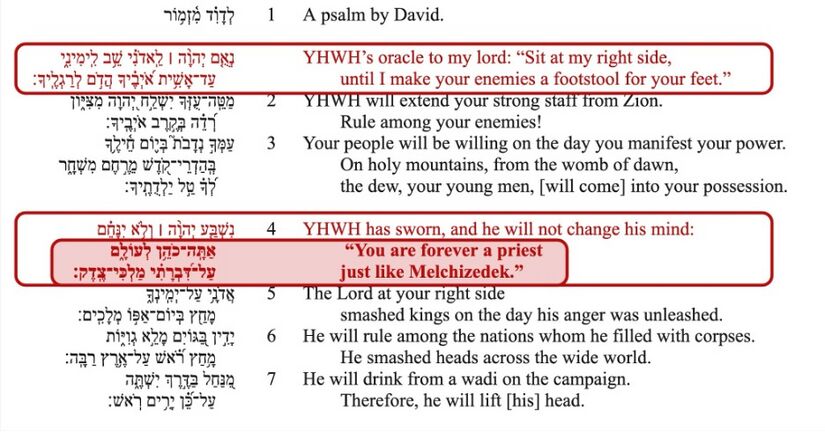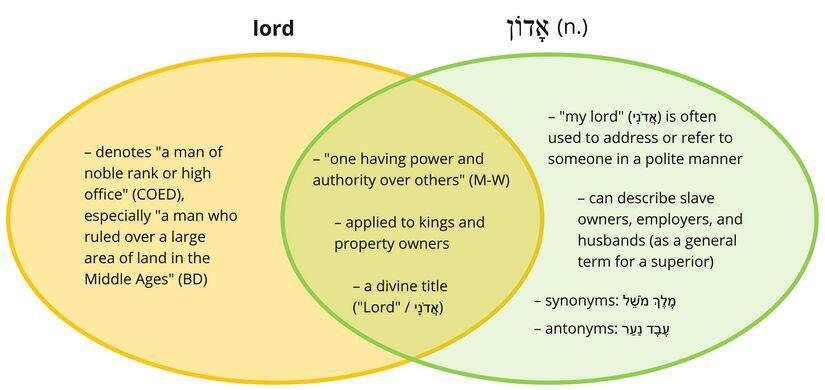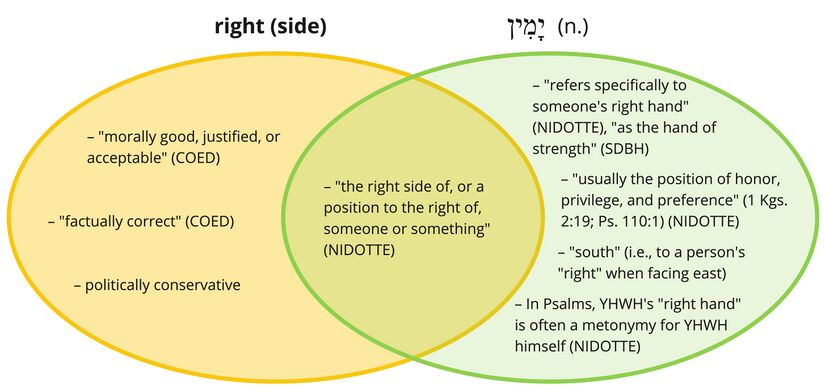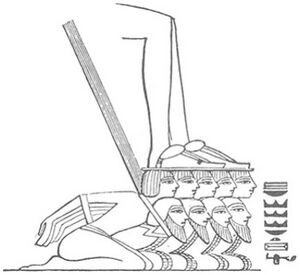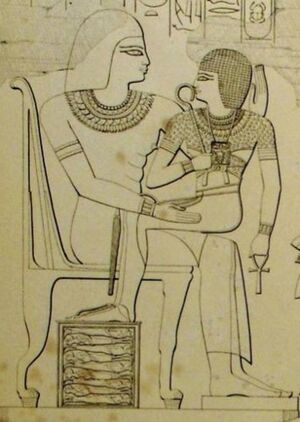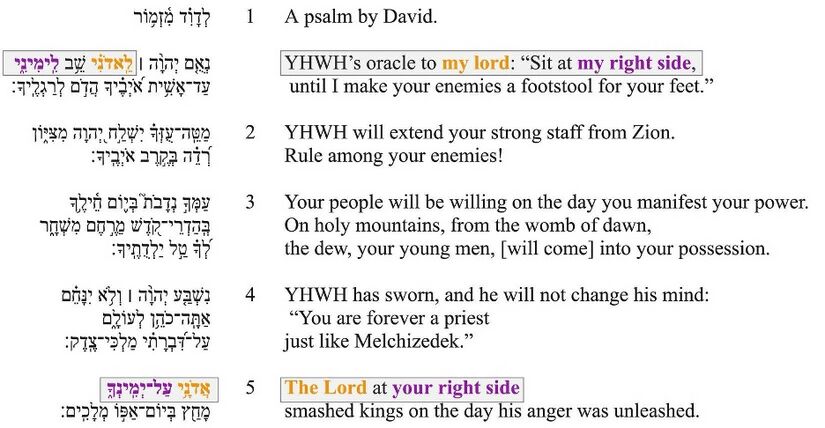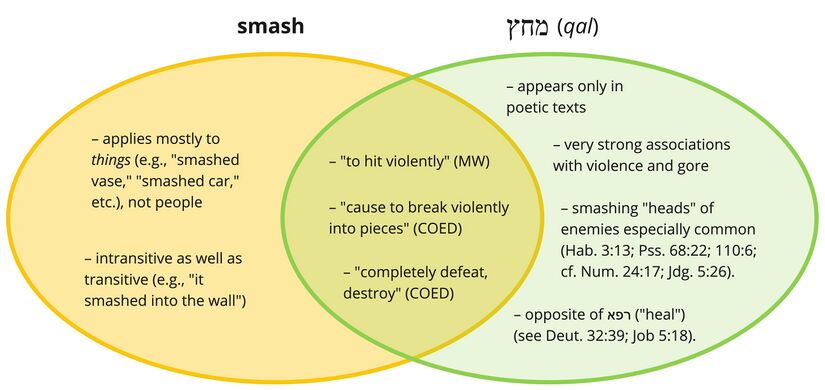Psalm 110 Translation
Jump to: Overview Verse-by-Verse
General Translation Tips
To translate poetry accurately and beautifully, a knowledge of both the source language's poetry and the target language's poetry is needed. So, here are the steps we recommend to follow when setting out to translate this or any psalm:
- Gain an Understanding of the Target Language’s Poetry/Arts. Research and analyze many examples from numerous genres of poetry, storytelling, and music in the target language and culture, and document findings. See our Local Arts Analysis Guide for help.
- Gain an Understanding of the Source Language’s (Hebrew) Meaning and Poetry. The aim of all our materials is to provide exactly this for the translator, poet/musician/artist, and consultant: an understanding of what the psalm means, as well as its poetics.
- Translate the Psalm in the Appropriate Local Art/Poetry Genre(s).
- Test the Translation with the Language Community. Seek feedback about both word choices and the form/genre/media of translation.
Overview: Psalm 110 as a Whole
These are the elements that we believe are most helpful to keep in mind during both drafting and checking translations, to help verify that the translation or performance is accurate beyond just a word- or verse-level; just as important is accuracy on the level of a whole. Additionally, these are elements that will guide decisions about performance in oral translations, songs, poems, or other kinds of art based on this psalm.
The following gives a basic Overview of the Psalm, answering the following questions:
- ● Title-what title best describes this unique psalm?
- ○ “YHWH’s Oracle to My Lord: Priest-King at the Right Hand”
- ● Purpose–why was this psalm written?
- ○ To proclaim God’s enthronement of the Davidic ruler and his everlasting priesthood, assuring victory over all enemies.
- ● Content–In summary, what is said in this psalm?
- ○ YHWH invites “my lord” to sit at his right hand, extends his scepter from Zion, swears an irrevocable oath establishing him “a priest forever according to Melchizedek,” and guarantees judgment over kings and nations.
- ● Message–what is the general theme of this psalm? What seems to be the
main point the psalmist wanted his audience to realize by hearing this psalm?
- ○ The Messiah-king rules with God’s own authority and an everlasting priesthood; YHWH himself ensures universal triumph.
Every psalm has a coherent story behind it. However, many
psalms are not written in typical "story" format, with a clear
beginning, middle, and end. Here, we attempt to understand the story and
background that prompted the psalmist to write.
- ● Story Behind-How do the various parts of the psalm fit together into a
single, coherent story? What is the main message/theme conveyed by this
"story behind"?
- ○ YHWH issues a royal oracle: “Sit at my right hand until I make your enemies a footstool” (v. 1).
- ○ From Zion the king’s scepter goes forth; his people willingly assemble in holy splendor on the day of power (vv. 2–3).
- ○ YHWH swears an oath that the king is “a priest forever according to the order of Melchizedek” (v. 4).
- ○ The Lord at his right hand shatters kings and judges the nations on the day of wrath (vv. 5–6).
- ○ Closing image: the king drinks from the brook and lifts his head—refreshment and assured triumph (v. 7).
- ● Background Situation-what are the series of events leading up to the time in which the psalm was written?

Knowing the layout of the sections of the psalm by sections helps us to understand the progression of thought as the poem progresses.
How to read the visual below: The picture below shows the main “chunks” or pieces of the poem. Verse numbers appear on the left. The second column has a title for each section. The large third column contains a brief summary of the section’s content. As you read through the content column, you will see important words and ideas highlighted in similar colors. The icons on the right may be used as memory aids.
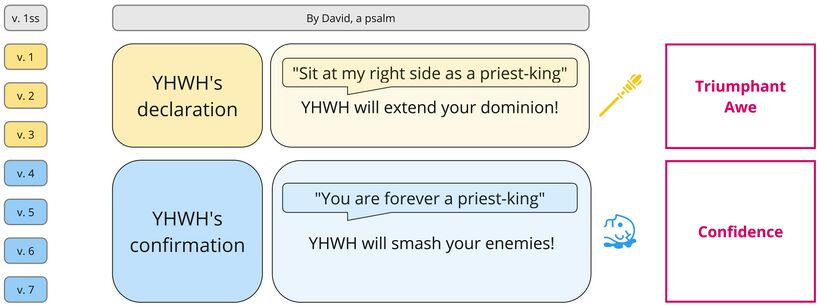
Progression–what is the flow of thought as the poem progresses?
- ● V. 1 — Divine invitation: “Sit at my right hand… until I make your enemies a footstool.”
- ● Vv. 2–3 — Rule extends from Zion; the people freely volunteer in holy splendor on the day of power.
- ● V. 4 — The oath: “You are a priest forever, according to the order of Melchizedek.”
- ● Vv. 5–6 — Day of wrath: the Lord shatters kings and judges among the nations.
- ● V. 7 — Final image: refreshment at the brook; the king lifts his head—victory secured.
Part of poetry is communicating emotion. Each section, and even each verse, can contain a number of different emotions. Here are the main emotional themes of each section:
- ● Awe and reverence at the enthronement at YHWH’s right hand (v. 1).
- ● Confidence and zeal in the king’s day of power and the people’s willing response (vv. 2–3).
- ● Solemn assurance/holiness in the everlasting priesthood by oath (v. 4).
- ● Gravitas and dread in judgment against hostile kings and nations (vv. 5–6).
- ● Relief and hopeful triumph in the closing refreshment and uplifted head (v. 7).
In poetry, it is important to keep track of who is speaking, who is the audience, and what it is that the speaker is trying to do with his words.
How to read the visual below: In the chart below, the left-hand column identifies the speaker; the right-hand column identifies the audience; the middle column summarizes the speech-acts by section.
- ● Speaker/Audience by section: v.1—YHWH speaks to “my lord”; vv.2–3—narration about the king and his people; v.4—YHWH’s sworn oath to the king; vv.5–6—the Lord at his right hand judges kings/nations; v.7—narration about the king’s refreshment and lifted head.
- ● Speech-acts: enthronement decree (v.1), royal extension (vv.2–3), priestly oath (v.4), judicial warfare (vv.5–6), victorious resolution (v.7).
In poetry, it is important to keep track of who is speaking, who is the audience, and what it is that the speaker is trying to do with his words.
Poetic Feature 1: Oracle + Oath Structure
Psalm 110 is framed by two divine speech acts: an oracle (v.1) and an oath (v.4). These anchor the poem’s authority and set the theological center—royal rule and everlasting priesthood.
Poetic Feature 2: Priest-King like Melchizedek
The fusion of kingship and priesthood is unique: the ruler is made “a priest forever” after Melchizedek. The oath guarantees permanence and holiness to his reign.
Poetic Feature 3: Right Hand, Scepter, and Footstool
Royal imagery compresses big ideas: God’s right hand (authority), Zion’s scepter (extent of rule), “footstool” (subjugation), and “day of wrath” (judicial victory) moving from Zion outward to the nations.
Prominence–what words, phrases, or ideas are most important in this psalm?: It is also important to consider how the author chose to draw attention to certain parts of the psalm. Here are the parts of the psalm that we believe are most prominent, and thus should be most prominent in a performance of the psalm.
- ● V. 1 (oracle) and v. 4 (oath) form the theological core—enthronement and everlasting priesthood.
- ● “Right hand,” “scepter from Zion,” “priest forever,” “day of wrath,” “judge among the nations”—key motifs for performance emphasis.
- ● The closing image (v. 7)—refreshment and lifted head—punctuates assured victory.
Verse-by-Verse Notes (Translation)
View Text
Contents
Verses 1-3: YHWH's Declaration
- The title for this section may be understood as What YHWH Declares. Here, YHWH declares an oracle, which is a message from a divine being, given by a prophet.
- This section may be divided into two parts:
- The first part contains a quoted speech of YHWH (verse 1)
- The second part contains an elaboration of that speech (verses 2–3)
- The second part speaks of the king’s rule over enemies (verse 2)
- Then, the second part contains mention of water (dew; verse 3)
- This pattern will repeat in verses 4–7.
- This section contains the 2ms suffix (“you” or “your”) 8 times, with multiple occurrences in each verse. So, this first section is characterized by direct addresses to the human lord. The first section explains the human lord’s work. The 2ms suffix only occurs once in the second section (verses 4–7). The second section focuses on the activity of YHWH in battle.
v. 1
| 1a | לְדָוִ֗ד מִ֫זְמ֥וֹר
|
A psalm by David.
|
| 1b | נְאֻ֤ם יְהוָ֨ה ׀ לַֽאדֹנִ֗י
|
YHWH’s oracle to my lord:
|
| 1c | שֵׁ֥ב לִֽימִינִ֑י
|
“Sit at my right side,
|
| 1d | עַד־אָשִׁ֥ית אֹ֝יְבֶ֗יךָ הֲדֹ֣ם לְרַגְלֶֽיךָ׃
|
until I make your enemies a footstool for your feet.”
|
Expanded Paraphrase The words in <i>italics</i> provide a fuller sense of the psalm; the text itself is in <b>bold</b>.
Notes
- The first line of this verse is a superscription. Superscriptions can identify the psalmist, the instruments, the tune, the setting, and other information. See our upcoming page and video on Superscriptions for more information.
- The superscription describes this poem as a psalm (מִזְמ֥וֹר). The Hebrew word "is a technical term for a song that was to be sung, perhaps with musical accompaniment."[1] In order to distinguish a psalm from other kinds of songs, in some languages it may be necessary to add a qualifier such as praise, religious, or worship; for example songs for worship or songs for praising God. The translator must make sure to translate the key term psalm consistently with other psalms and with the way the word psalm is translated in the New Testament.
- The phrase by David (לְדָוִד) means that king David is the author of this psalm.
- If the name David is unknown in the target language, it may be best to transliterate the name based upon the Hebrew letters or upon an existing translation from a language of wider communication.[2]
- This phrase implies that David has written the psalm. Some languages may require that the verb be made clear: A psalm written by David or A psalm composed by David. Some languages may require an active construction: David wrote this psalm or David composed this psalm.
- For more detail see the webpage Ledavid.
- The phrase translated YHWH's oracle (נְאֻם יְהוָה) is a technical expression. It introduces a prophetic oracle, which is a direct quotation from YHWH that is delivered by a prophet.[3] The rest of verse 1 after the phrase to my lord, and perhaps the whole psalm, is a direct quotation of YHWH's words.
- Translators will need to be consistent in how they render the term YHWH throughout the Bible. Many translations render the divine name YHWH as LORD. Translators should be aware that in this verse, the rendering LORD can make it look like this word, which in Hebrew clearly refers to God, is the same as the following word for lord, which is not the divine name and can refer to God or to a human being (in this case, it refers to a human). In the Hebrew text, the words are so different that no one could confuse them. Here are some of the ways that translators have chosen to render the word YHWH:
- transliteration, such as Jehová (RVR), YHVH (BTX), or Yahweh (Hausa CLB, LEB).
- include both the word for Lord and the transliteration (BDS)
- include both the word for Lord and the word for God (NFC: Seigneur Dieu)
- render an attributive name that describes a characteristic of YHWH: L'Eternel (BDS, S21)
- or, maintain the word LORD to render YHWH, and choose a different word for the second instance of lord, such as king (Hausa LMT: sarki; NFC: roi) or master (PDV: maître). See our upcoming page about translating the Divine Name.
- Many translations render the noun phrase 'YHWH's oracle/proclamation' as a clause: "the Lord says/said to my Lord" (NIV, ESV, NLT, GNT). The NET more closely reflects the grammar of the Hebrew text: "Here is the LORD's proclamation to my lord."[4]
- For languages that need to render the noun phrase as a verbal idea, we recommend something like: Here is what Yahweh says/said to my lord. In one sense, YHWH has already said it to the prophet (past tense), but in another sense, the message is being communicated to the hearer now for the first time (present tense). In Psalm 110, because the addressee of the oracle is identified as my lord and because the lord is hearing if here for the first time, we prefer to translate it with the present tense: Here is what Yahweh says to my lord.
- The oracle is addressed to my lord.
- The pronoun my refers to the author of the psalm, who is King David (see the previous clause). For cultures where the referent may not be clear, translators may make it clear within the text (my (David's) lord) or add a footnote.
- A lord is a "man who is in a position of authority over another person."[5]
- The title lord is often applied to kings, and thus the use of this word is the first of several indications in the psalm that the addressee David is speaking to is a king.[6]
- The third-person phrase my lord is often used when an inferior addresses a superior.[7] Here, the psalmist David is directly addressing his lord. It is as though David is standing before his lord and telling his lord the words of YHWH.
- In some cultures, it may be inappropriate to address a superior using the third person. In such cases, the conventions of the culture for addressing a superior should be used. One possible strategy is to you, my Lord.
- The following diagram compares the English word lord with the Hebrew term; the left-hand part of the yellow circle provides a meaning of the English term that does not apply to the Hebrew term; the right hand part of the green circle provides meanings of the Hebrew term that do not apply to the English word. The middle contains meanings that apply to both words:
- This verse is one of the most-quoted verses in the New Testament. However, translators should be very careful not to bring later New Testament ideas backwards into the translation of this Old Testament text.
- Since many translation teams begin with the New Testament, it will be important to check that the translation of this verse takes into account the places where the verse is quoted or alluded to in the NT (Matthew 22:44; 26:64; Mark 14:62; 16:19; Luke 20:42-43; 22:69; Acts 2:34-35; 5:31; 7:55-56; Romans 8:34; 1 Corinthians 15:25; Ephesians 1:20; Colossians 3:1; Hebrews 1:3, 13; 8:1; 10:12-13; 12:2; and 1 Peter 3:22-24). Translation teams should prioritize faithfulness to the Hebrew before making any attempts to harmonize with the Greek quotations in the New Testament.
- YHWH invites the king to sit at my right side (שֵׁב לִימִינִי).
- Especially for cultures in which the "right side" does not clearly communicate privilege and honor, translators should make this meaning clear, as the NLT does: Sit in the place of honor at my right hand.
- The following diagram illustrates the similarities and differences between the Hebrew and English terms for right (side):
- Because YHWH himself sits on a heavenly throne (see, for example, Ps. 11:4), to sit at YHWH's right might mean either to sit on a throne next to YHWH's throne or to sit next to YHWH on his throne. In either case, the king is invited in verse 1 to occupy a place of high honor in YHWH's heavenly throne-room. Because only priests were allowed access into YHWH's throne-room,[11] the king's position at YHWH's right anticipates the promise in verse 4 that the king is a priest forever.[12]
- The two lines of the quotation are joined by the word until (עַד).
- This word might be taken to mean that the king will stop sitting at YHWH's right (verse 1a) once his enemies have been subdued (verse 1b). Sometimes, however, the word is used to "express a limit … beyond which the action or state … still continues."[13] For example, Ps. 112:8 says, "His heart is steady; he will not be afraid, until he looks in triumph on his adversaries" (ESV). Here, the person's heart will likely also remain steady even after he looks in triumph. So, in Ps 110:1, it is possible that the king continues to sit at YHWH's right hand even after all of the enemies are subdued; the emphasis is on the fact that the king sits at least until the enemies are subdued.
- YHWH promises that he will make your enemies a footstool for your feet.
- An enemy (אוֹיֵב) is not quite the same as one who hates, even if an enemy may be hateful. The term refers to a "person who has a conflict with someone else and acts accordingly."[14] Thus, the person is an adversary, that is, someone who contends with, opposes, or resists.
- For languages that require a verbal idea, translators may consider something like people who contend with you or people who act in conflict with you.
- A footstool (הֲדֹם) refers to "a low stool... for resting the feet on when sitting," and it is "often associated with authority," such as the authority of a king.[15] The important point is that in the biblical world, the placement of enemies under one's feet was a figure of speech to communicate authority and victory over those enemies.[16]
- For cultures in which the image of a footstool is not available, or for cultures in which calling someone a footstool would not communicate authority and victory, translators can consider the following strategies:
- It may be possible to render it as the piece of wood where the feet rests (when sitting) or the resting place of the feet (see 1 Chr 28:2 LXX) or the place where the feet rest (when sitting) (see Ps 132:7 LXX).
- Several non-English translations drop the footstool image altogether and render the phrase I put your enemies under your feet. However, translators should not remove an image from poetry unless there is no good way to retain it. If translators pursue this strategy of removing the image, they should still seek to communicate the image's meaning of victory over enemies in the local language.[17]
- Bratcher and Reyburn suggest something like “I will place your enemies under your power” or “I will make you defeat your enemies.”[18] Better would be to both keep the imagery and explain it within the text, such as I will place your enemies under your authority, like a footstool under your feet or I will make your enemies like a footstool under your feet: completely under your control.
v. 2
| 2a | מַטֵּֽה־עֻזְּךָ֗ יִשְׁלַ֣ח יְ֭הוָה מִצִּיּ֑וֹן
|
YHWH will extend your strong staff from Zion.
|
| 2b | רְ֝דֵ֗ה בְּקֶ֣רֶב אֹיְבֶֽיךָ׃
|
Rule among your enemies!
|
Expanded Paraphrase The words in <i>italics</i> provide a fuller sense of the psalm; the text itself is in <b>bold</b>.
Notes
- Verses 1 and 2 are bound together as a unit by the repetition of the word your enemies (אֹיְבֶיךָ, see the note in verse 1) and by a special structure. In this special structure, the first and last phrases contain repetition, then the second and second-to-last phrases contain repetition, and so on. This structure (called a chiasm) gives emphasis to the terms in the middle. Here in verses 1 and 2, the outer repetitions are verb forms (imperatives and yiqtols), and, importantly, the middle terms are symbols of royal rule (the footstool and strong staff). It looks like this:
- In verse 2, the psalmist begins to speak in his own voice, elaborating on YHWH's words in verse 1. So, the direct quotation of YHWH's words only occurs in verse 1 (and also later in verse 4).[19]
- The phrase your strong staff (מַטֵּה־עֻזְּךָ) has several notable features:
- There are several words for staff in Hebrew. The word used here means a "stick, usually made of wood, used for walking or as an attribute of a ruler, also used for threshing" and "associated with authority and punishment."[20]
- In Hebrew, the phrase literally says the staff of your strength.[21] The second noun, strength, describes an attribute of the first noun, staff.
- Thus, some translations have "strong staff" or "mighty scepter" (NIV, ESV, CSB).
- Some translations make it clear that the king's strong staff is a symbol[22] for his kingdom: "your powerful kingdom" (NLT), "your royal power" (GNT), "your dominion" (NET). This is a useful strategy in cultures in which a staff cannot communicate power and authority.
- The preferred method, if possible, is to combine the first two options, as in the Hausa CLB: the staff of your kingdom/rule.[23] This option has the benefit of retaining the staff imagery while adding a brief explanation of its meaning as a symbol of strength and authority.
- The phrase your strong staff is in an unusual position in the Hebrew text. It has been placed at the front of its clause. This positioning not only has a poetic purpose (creating a chiasm; see the first note on this verse), but probably also signals a contrast with the footstool mentioned at the end of the previous clause. By fronting "your strong staff", the author indicates his transition from talking about one symbol of royal rule (the footstool) to another (the strong staff).
- Translators may choose to bring out this contrast with something like: As for your strong staff, YHWH will extend it from Zion.
- The phrase extend…from Zion means that the king's rule will reach out "from Jerusalem…to other lands" (as in the TEV).[24] So, a possible strategy is to render the clause something like: the Lord will cause you to rule from Zion all the way to other lands.
- The word Zion refers to Jerusalem, and specifically to the hill upon which the temple was built. The city of Jerusalem was the religious and political center of the land of Israel, and it was associated with strong military defense. Zion was also associated with David (2 Sam 5:7), which is significant in this psalm (see also Psalm 2:6). The temple was the place where YHWH dwelled and therefore had his throne (Ps 9:11).[25] Since the word Zion will be unfamiliar in many cultures, translators may want to consider either 1) making the meaning clear with a rendering like from Zion, the hill of God or 2) providing an explanation in a footnote.
- The phrase Rule among your enemies! has some important features for the translator to consider:
- The word rule is in the imperative form, and so some translations understand it to be a direct quotation of YHWH's words to the king. These translations render the phrase in quotation marks (NIV, NASB, GNB, REB). However, it is just as likely that the psalmist is speaking for YHWH here, and in that case, quotation marks are not necessary.
- Though the word rule is in the imperative form, here it does not express a command. Rather, it is used "to express a distinct assurance... or promise."[26]
- Thus, some translations use the future tense here, such as: and you will rule (CEV, NLT, NIV84; see also French BDS: tu domineras; Hausa CLB: za ka yi mulki).
- Translations that render this as a wish, such as May the Lord extend your rule… (French TOB), are not accurate.
- The promise of rule that is expressed in this clause (verse 2b) happens after or because of what YHWH has done to extend the king's power in the previous clause (verse 2a). The relationship between the clauses is unexpressed in Hebrew.
- Translators may choose to render the two clauses in a way that the logical relationship between these clauses is clear. If necessary, translators may supply a connector like so or therefore. The result would be something like YHWH will extend your strong staff from Zion, so rule among your enemies!
- For the phrase among your enemies (בְּקֶרֶב אֹיְבֶיךָ), some translations have "over your enemies" (NLT, GNT). A potential issue with this translation is that it loses the sense of locational movement: the king's rule is extended "from Zion" (verse 2a) so that his kingdom is now "in the midst of" those who are outside Zion (verse 2b).
- To deal with this problem, a possible strategy is that of the Hausa CLB, which combines a natural wording for "ruling over" with the location to describe the enemies: over all your enemies around you![27]
v. 3
| 3a | עַמְּ ךָ֣ נְדָבֹת֮ בְּ י֪וֹם חֵ֫ילֶ֥ ךָ
|
Your people will be willing on the day you manifest your power.
|
| 3b | בְּֽהַדְרֵי־קֹ֭דֶשׁ מֵרֶ֣חֶם מִשְׁחָ֑ר
|
On holy mountains, from the womb of dawn,
|
| 3c | לְ֝ ךָ֗ טַ֣ל יַלְדֻתֶֽי ךָ׃
|
The dew, your young men, [will come] into your possession.
|
Expanded Paraphrase The words in <i>italics</i> provide a fuller sense of the psalm; the text itself is in <b>bold</b>.
Notes
- Verse 3 is, in the words of one Bible translation, "one of the most difficult texts in all the Bible" (see the footnote for more detail).[28] The difficulty is largely due to textual issues. We follow the MT throughout verse 3 with one exception: we read on holy mountains (בְּהַרְרֵי קֹדֶשׁ) instead of "in holy garments" (בְּהַדְרֵי קֹדֶשׁ).
- The whole verse might be summarized as follows: "your people will join your war campaign voluntarily and in large numbers."[29]
- The first half of the verse states this literally ("your people will be willing on the day of your power").
- The second half of the verse states this figuratively ("the willing volunteers will be like dew that covers the mountains at the break of dawn").
- Thus, "the thought of the first half of the verse is repeated with an image and further painted out" in the second half of the verse.[30]
- The first line of the verse, your people will be willing on the day of your power, has some important features:
- The NGÜ shows a possible translation strategy to bring out this emphasis: with all their heart your people stand ready...
- In Hebrew, this line lacks a verb, and so we have supplied the verb will be in our rendering. In English, the future tense is best here because the phrase on the day of your power (בְּיוֹם חֵילֶךָ) describes a time yet to come: "your people will be willing on the day of your power." The phrase as a whole refers to the time when the king will go to war against his enemies.
- Some languages may have both an imminent future tense and a distant future tense.[33] In such cases, it may be best to follow the grammar of the French translations that treat the line as a zero conditional that uses when and the present tense. In French, such a rendering puts the situation in the future without implying when in the future it will happen:
- Your people are (full of) devotion On the day (when you gather) your army (NVS)[34]
- Your people are full of ardor, when you gather your army (S21).[35]
- The phrase on holy mountains (בְּהַרְרֵי קֹדֶשׁ) refers to the mountains around Jerusalem.[40] While many modern translations agree with our rendering,[41] a majority of modern translations follow the Masoretic Text in reading "holy garments."[42] The difference between the two readings is a single letter (ד vs. ר, which look nearly identical). Our preferred reading fits the context very well; for other arguments for and against our reading see The Text, Grammar, and Meaning of Ps. 110:3.
- The word holy is a key term. It means a "state in which humans or objects have become part of the realm of God and his service" and are "therefore no longer accessible to humans unless they have gone through special rituals."[43] It refers to divine beings, people, things, or places that are set apart, exclusive, important, and valuable. So, the opposite of holy is not sinful but rather common, mundane, or ordinary.
- The Hebrew word we have rendered as mountains can refer to anything from a small hill to a mountain. The elevated areas around Jerusalem were not much more than hills, especially from the perspective of those who live in mountainous areas.
- The phrase womb of dawn is difficult, but it is probably a figure of speech that refers to the way in which the dew falls on the mountains early in the morning, at the break of dawn, as though the dawn were giving birth to the dew-like army of young men.
- The third line of the verse, the dew, your young men, [will come] into your possession, has some important features:
- Some cultures may lack a word for dew, which is moisture that covers the ground in the morning. To find a substitute, consider some possible connections that the psalmist might have meant to draw between the king's army and the dew:
- Dew is a gift from God and a sign of his blessing.[44] The king's willing army is a gift to him from YHWH.
- Dew comes in the morning.[47] The king's army is eager to fight for him (coming early in the morning).
- Dew causes crops to grow and is therefore essential for flourishing in the land.[48] The king's army will make him successful.
- The term we have rendered your young men literally means youth in Hebrew, and here it probably refers to the king's army.[49] Thus, the NIV renders it your troops. These young men are compared to the early-morning dew that falls on the mountains of Zion.
- Grammatically speaking, the phrase your young men explains what the psalmist means by the dew: the dew, that is, your young men or the dew, in other words, your young men.[50]
- Some English translations make the comparison clear: as the dew (NASB95) or like dew (NIV, NRSV, GNB). In many languages, it will be important to make the comparison similarly clear. Numerous as the dewdrops may be another good option.
- Other English translations seem to understand the dew to be a symbol of young age. Translators who understand the meaning in this way should be clear, such as the dew that symbolizes the freshness of youth. An example of an unclear rendering that probably intends this meaning is the ESV: the dew of your youth (see also NIV84, CSB, REB, NET). This rendering could easily mean the dew that occurred when you were a youth, which does not seem to fit here.
- The phrase we have translated as [will come] into your possession means that the young men come to belong to YHWH. The phrase lacks a verb in Hebrew. We have supplied will come. In Hebrew, coming to someone (using the Hebrew preposition לְ, as is the wording here) means coming into that person's possession.[51] The ESV has will be yours, and this is a possible rendering of the phrase.[52] The future tense is appropriate here since the psalmist is speaking of a future event.
- The title of this section may be understood as YHWH confirms his king.
- YHWH makes his confirmation in the form of an oath, which is a solemn promise.
- This section is bound together by allusions to Genesis 14:
- The section features Melchizedek (see Gen 14:18–20).
- The section describes a battle against wicked kings (see Gen 14:1–16).
- The second half of the psalm (verses 4–7) echoes the first half of the psalm (verses 1–3):
- The first part contains a quoted speech of YHWH (verse 4)
- The second part contains an elaboration of that speech (verses 5–7)
- The second part speaks of the king's rule over enemies (verses 5–6)
- Then, the second part contains mention of water (wadi; verse 7)
- For more detail see Poetic Feature 1: Claimed and Confirmed.
- Psalm 110:4 is based upon a story in Genesis 14:18-20, and translators should also take these Genesis verses into account when developing their translation of this verse. Psalm 110:4 is also quoted three times in the New Testament book of Hebrews:
- Hebrews 7:21 quotes the first line of the verse and part of the second line.
- Hebrews 5:6 and 7:17 quote the second line of the verse.
- While translators should take these New Testament quotations into account, they should prioritize faithfulness to the Hebrew text of Psalm 110:4 before making any attempts to harmonize with the Greek quotations in the New Testament.
- Here the king's priestly status, which was implied in verse 1, is made clear and confirmed with an unchanging oath: YHWH has sworn, and he will not change his mind: "You are forever a priest..."
- The purpose of an oath is to confirm the sincerity of a commitment to do or not do something. Thus, by swearing an oath, YHWH not only claims that the king is a priest, but YHWH also commits himself to ensuring the eternal continuation of the king's priestly status. The king will never cease to sit in YHWH's presence and on YHWH's throne.
- In modern English, the word swear with no direct object means to use obscene or profane language,[53] and that is not the meaning here. Other languages may also require a direct object for the verb sworn. In this case, possibilities include sworn an oath, said/made a promise, or made a commitment.
- Some languages may require an indirect object: sworn to you.
- Translators should be careful that the words chosen for swearing an oath in the target language do not imply ancestor worship or magic. Translators should also make sure that their rendering does not make it seem like the person swearing the oath or making the promise (in this case, YHWH) is someone of lower status than the person to whom the oath or promise is made.
- The Hebrew word we have rendered change his mind has a wide variety of meanings; the right one must be determined by context. Here, the meaning is tied to the oath (that is, the promise) that YHWH made to the king to make him a priest forever.
- So, translations like relent (which implies that the oath is primarily about punishment; NKJV), or repent (which implies that YHWH has done something wrong; KJV, ASV, YLT) are inappropriate here.
- In addition to 'change his mind,' other good translation possibilities include: break his vow (NLT); take it back (GNB, CSB); or revoke it (NET).
- The first line of this verse introduces a quotation of what YHWH says in the second line. In many languages, translators will need to make this introduction of the quotation clear by adding the word saying at the end of the first line (see Hausa CLB: cewa).
- The pronoun you in the quotation refers to David's lord. The present tense of the verb you are... is assumed from context.
- The word priest is a key term that refers to a "person ordained and consecrated to perform religious services on behalf of others."[54] Translators should ensure that the word they choose matches other biblical instances of the term, particularly in Genesis 14:18.
- The phrase translated just like (עַל־דִּבְרָתִי) occurs only here, and it probably means "in relation to." So, the whole phrase might be translated like Melchizedek.[55]
- Some English translations render this phrase as after the order of (ESV, KJV), according to the order of (NASB, NRSV), in the order of (NIV). Though the word order can mean "a group of people united in a formal way,"[56] in modern popular English, the word order usually connotes a command, which is not the meaning here. Translators may want to consider the GNB's rendering, which makes the priestly nature of the order clear: in the priestly order of. Other acceptable renderings that communicate the meaning well are according to the pattern of (CSB), after the pattern of (NET), according to the manner of (LEB).
- The king in Ps. 110 is like Melchizedek primarily in the sense that he, like Melchizedek, is both king and priest in Jerusalem.[57]
- Although some translations read Melchizedek (מַלְכִּי־צֶדֶק) as a phrase ("a rightful king"),[58] the term is most likely a title or a name, and thus refers to Melchizedek from Gen. 14:18.[59]
- So, the preferred strategy is that the name should be transliterated using the same name found in Genesis 14:18 and Hebrews 5:6, 7:17.
- Since the meaning of the name is significant, translators could consider including the meaning of the name, king of righteousness, within the text along with the name Melchizedek, or separately in a footnote.
- Verses 5-7 describe a vision in which God gives the king victory over his enemies.
- Back in verse 1, the word lord ("my lord": אדני) referred to the king, who was invited to sit at YHWH's "right side" (ימין). Here in verse 5, though, the word lord (אדני) refers to YHWH, who is at the king's right side (ימין). It looks like this:
- At times, it is difficult to tell whether the subject of the clauses in verses 5-7 is the psalmist's king, or it is YHWH. This is especially true in verse 7. This vagueness may be intentional - for David, the identity of YHWH and the king may be so close that they are difficult to tell apart. In sum, though, we believe that the subject throughout verses 5-7 is most likely YHWH. For more detail, see Poetic Feature 2: The Lord and the lord.
- The two lines in verse 5 may be either one clause ("YHWH, who is at your right hand, has crushed...")[60] or two clauses ("YHWH is at your right hand. He has crushed...").[61]
- The phrase The Lord at your right side (אֲדֹנָ֥י עַל־יְמִֽינְךָ֑) is an unusual position in Hebrew. It is placed at the front of its clause for emphasis. The emphasis is on confirming that it is indeed YHWH and no one else who subdued the king's enemies.
- In English, the emphasis might look something like this: "(Yes), it's the Lord, who is at your right hand, who smashed kings... He is the one who subdues your enemies for you."
- This emphasis on confirming YHWH's identity as the one who defeats enemies fits well with the overall mood and purpose of the psalm, which is to assure the king that YHWH is going to take care of his enemies for him.
- In verse 1, the king who was at YHWH's right side was in a position of honor. The same Hebrew word we have rendered as right side is used in verse 5 also, forming a poetic link between the two verses. However, here it is YHWH who is at the king's right side - the positions are reversed. In this case, for YHWH to be at the king's right side shows that YHWH is in a position of power and strength, able to protect the king and fight for him (verses 5b-7).
- The subject throughout verses 5-7 is probably YHWH. YHWH is named as the subject in verse 5a, and "there is no indication in the sequence of clauses in vv. 5-7 that we should assume a change of subject."[62]
- So, even though it is difficult to distinguish between YHWH and the king in Hebrew thought, readings that imply the king is the subject of these verses (NJB, NET) are not preferred.
- The tense(s) of the verbs in verses 5-7 (smashed... will rule... filled... smashed... will drink... will lift) are treated in a variety of ways in the modern translations.[63] The most important thing about these verbs is that they describe events that will take place on or after a future "day of his anger" (בְּיוֹם־אַפּוֹ, verse 5b).
- The verbs in the phrases smashed kings (verse 5b), filled with corpses (verse 6a), and smashed heads (verse 6b) refer to events that happen on "the day of his anger," which is a day in the future. The reason we have rendered these verbs as past tense is that they are in a Hebrew verb form (qatal prophetic perfect) that describes "events which occurred in a vision or in a dream."[64] A good way to think about what is happening in verses 5-7 is this: 1) the psalmist sees a vision of what will happen in the future, 2) when the vision is over, he reports what he has seen, and 3) from the perspective of the psalmist, then, the report about the events can use the past tense. For example: "I saw a vision of the future. In it, YHWH smashed kings…"
- Most translations translate these verbs using the future tense. This is also an accurate translation ("he will smash kings…he will fill with corpses…he will smash heads).
- Some modern translations render all of the verbs in the present tense.[65] However, the entire psalm is a prophetic report that describes future events (see the notes on the term prophetic oracle in verse 1). So, translations that render the verbs in the present tense are inaccurate.
- The verbs in the phrases will rule (verse 6a), will drink (verse 7a) and will lift (verse 7b) are in a different verb form (yiqtol) from the verbs smashed and filled. This verb form describes events that happen after the day of YHWH’s wrath. Once YHWH has destroyed all of the kings, he will drink from the wadi, and he will rule the nations, and he will lift his head.
- The word smashed is a repeated word in this psalm that also appears in verse 6b. The word appears only in poetic texts and has very strong associations with violence and gore—smashing "heads" is especially common.[66] The following diagram compares the Hebrew term with the English word smash. Definitions in the yellow left side apply only to the English word, while definitions in the green right side apply only to the Hebrew word. Definitions in the middle, where the shapes overlap, apply to both the English and Hebrew words:
- The phrase on the day his anger was unleashed is literally on the day of his anger in Hebrew. However, this refers not just to the day when he gets/becomes angry (CEV, GNT). Instead, the whole psalm looks forward to a future time of God's action (it is eschatological). So, the phrase refers specifically to the day of judgment (HFA), and translators may likewise consider adding reference to judgment to make the meaning clear. Since the Hebrew phrase refers to the judgment day when YHWH will not only become angry but will also act upon his anger by punishing the wicked, we have added the words was unleashed. This is similar to the NET translation: the day he unleashes his anger (see also NGÜ).
- The word smash is one of several connections between Psalm 110 and Balaam's final oracle in Numbers 24:15–19. Similarly, Psalm 110's connection with Genesis 14 is not limited to the mention of Melchizedek (in verse 4). Both passages include a worldwide battle against wicked kings that ends in the winner drinking. See Poetic Feature 3: Pentateuchal Prophecy for more detail.
- Most modern translations understand the verb he will rule (יָדִין) to refer to YHWH judging (and punishing) the nations. The verb may also, however, refer to "broader tasks of establishing and maintaining order (through governing and administering)," and, in the Psalms, it sometimes refers to "God's sovereign rule over ... the nations in general."[67] So verse 6a may say that YHWH, once he has destroyed the wicked kings, will rule justly over the nations.
- The prepositional phrase among the nations (בַּגּוֹיִם) probably indicates the place where the ruling/judgment takes place. The preposition among (בְּ) "indicates that the peoples whom he judges are gathered around him."[68] The word often refers to non-Israelite nations when used in the plural, as it is here.[69]
- In verse 6a, most translations say fill with corpses, but some translations follow a variant Hebrew text to say fill the valleys with corpses (NET, ELB). Not much about the meaning changes by following this rendering.
- We have supplied the word whom in the clause whom he filled with corpses, so that what is filled is the nations (גּוֹיִם). The need to supply a word like whom is not uncommon when rendering certain Hebrew constructions into English.[70] Several modern translations provide other strategies to arrive at the same meaning (in which the corpses fill the nations) such as:
- "He will execute judgment among the nations, filling them with corpses" (ESV).
- "He will judge among the nations; he will fill them with corpses" (LEB, see Hausa CLB[71]).
- Both of the above strategies supply the direct object them. They also make the verb tense simultaneous with the tense of the first verb of the sentence.
- For the meaning and tense of the verb smashed (מָחַץ), see notes on v. 5.
- The word heads is a singular noun (רֹאש) in Hebrew, but it may be understood collectively and therefore translated as plural.[72]
- In some translations, the heads are a figure of speech for rulers/kings. Given the close relationship of verse 6b with verse 5b, which mentions kings, the word heads may be short for the heads of kings. This is the reading of the NIV: the rulers of the whole earth (see also ELB).
- However, in this context it is unlikely that the word heads is a figure of speech for leaders, because the verb smash is often associated with the smashing of literal heads.[73] So, this reading is dispreferred.
- The phrase across the wide world (עַל אֶרֶץ רַבָּה) has a few features for the translator to consider:
- The phrase the wide world conveys that the action happens everywhere. English translations that capture this well include the wide earth (ESV, NRSV); the whole earth (NIV, NLT); the entire world (CSB). The rendering a broad country (NASB95) is too focused on a single country, which is unlikely to be the meaning of the Hebrew here, since the phrase is in parallel with the phrase among the nations that is in the first half of the verse.
- The phrase across the wide world could be behaving in one of two different ways:
- It may attach to the verb smashed, so that the phrase describes the scope of the act of smashing. This is the understanding of the NET translation: shatters their heads over the vast battlefield, and the JPS: crushing heads far and wide (see also EÜ). This is the preferred reading.
- It may attach to the noun heads, and therefore describe the scope of the power of these "heads." In this reading, the "heads" are a figure of speech for "rulers/kings," which is a dispreferred reading (see the note above).
- Verses 5-7 seem to describe a single vision in which YHWH, like a warrior, crushes his enemies and refreshes himself with a drink. It is common in the Bible to describe YHWH as a human warrior (Exod. 15:3; Ps 78:65). It is natural for the warrior, having smashed heads across the wide world, to drink water to refresh himself.[74] More significant is the fact that he drinks water in enemy territory, which is an action that shows dominance over enemies.[75]
- In many modern translations, translators insert the king as the subject of verse 7 (le roi, PDV). However, there is no clear subject change in Hebrew. See the notes on verse 5.
- YHWH drinks from a wadi. A wadi is "a relatively steep and narrow valley following the course of a stream, which is often dry, except for the rainy season."[76]
- English translations render this word as either brook or stream, both of which can inform the translator's choice for a local vocabulary word.
- In the larger poetic structure of the psalm, the mention of a wadi in verse 7 parallels the mention of dew in verse 4. See Poetic Feature 1: Claimed and Confirmed for more detail.
- The phrase translated on the campaign (בַּדֶּרֶךְ) is, literally, "on the way/road/path." In the military context of these verses, "on the way/road/path" probably refers to the warrior's campaign (see 1 Samuel 15:18, 20). The word 'campaign' is definite (the campaign, not a campaign) because we can identify it from the preceding verses. In verses 2 and 5, the conquering of enemies outside of Zion suggests a "journey" or "campaign."
- The phrase on the campaign (בַּדֶּרֶךְ) might be attached to either:
- (2) the act of drinking: "he will drink on the campaign, from a wadi."[79]
- The whole phrase from a wadi on the campaign is placed in an unusual order in Hebrew. It is at the front of the clause to emphasize that the warrior takes a drink from a wadi while on the military campaign, that is, the king drinks from water in enemy territory. Drinking the water that is in a foreign land during or after battle is an act that shows dominance over that land.
- The phrase therefore, he will lift his head has some important features:
- The word therefore (עַל־כֵּן) introduces the outcome of previously stated actions, events, or reasons. In this case, the action he will lift his head is the outcome of having drunk the enemy's water; now he is refreshed and confident that his victory is complete.
- To lift his head is a figure of speech that symbolizes the joy that comes when someone has victory over their enemies. Some translations may choose to make the subject of the verb meaning clear: he will lift his head in victory.
- The subject of the verb lift is YHWH, and the head belongs to YHWH. In some languages, it may be helpful to make the subject of the verb clear: YHWH will lift his head.
- The same word for head appeared in verse 6. Thus, there is a poetic contrast in the psalm between YHWH smashing the kings' heads in verse 6 and YHWH's lifting his own head here in verse 7. If possible, the translator should render the two instances using the same root word in the local language.
- Alan KamYau, Chan. 2016. ”7 A Literary and Discourse Analysis of Psalm 110.” In Melchizedek Passages in the Bible: A Case Study for Inner-Biblical and Inter-Biblical Interpretation, 97-118. Warsaw, Poland: De Gruyter Open Poland.
- Alter, Robert. 2011. The Art of Biblical Poetry. Philadelphia, PA: Basic Books.
- Baethgen, Friedrich. 1904. Die Psalmen. Göttingen: Vandenhoeck und Ruprecht.
- Barbiero, Gianni. 2014. "The non-violent messiah of Psalm 110". Biblische Zeitschrift 58, 1: 1-20.
- Barthélemy, Dominique. 2005. Critique Textuelle de l’Ancien Testament. Vol. Tome 4: Psaumes. Fribourg, Switzerland: Academic Press.
- Booij, Thijs. 1991. "Psalm Cx: Rule in the Midst of Your Foes!" Vetus Testamentum. Vol. 41, no.: 396-407.
- Bratcher, Robert G. and William David Reyburn. 1991. A Translator’s Handbook on the Book of Psalms. UBS Handbook Series. New York: United Bible Societies.
- Briggs, Charles and Emilie Briggs. 1907. A Critical and Exegetical Commentary on the Book of Psalms. International Critical Commentary. New York: C. Scribner’s Sons.
- Caquot, André. 1956. "Remarques sur le Psaume CX." Semitica. Vol. 6: 33-52.
- de Hoop, Raymond, and Paul Sanders. 2022. “The System of Masoretic Accentuation: Some Introductory Issues”. The Journal of Hebrew Scriptures 22.
- Delitzsch, Franz. 1877. Biblical Commentary on the Psalms: Vol. 3. Edinburgh: T&T Clark.
- Driver, G. R. 1964. "Psalm CX: Its Form Meaning and Purpose." In Studies in the Bible: Presented to Professor M.H. Segal by His Colleagues and Students. Edited by J. M. Grintz & J. Liver. Jerusalem: Published for the Israel Society for Biblical: 17-31.
- Emadi, Matthew. 2022. The Royal Priest: Psalm 110 in Biblical Theology. New Studies in Biblical Theology. Downers Grove: InterVarsity Press.
- Fokkelman, J. P. 2000. Major Poems of the Hebrew Bible: At the Interface of Hermeneutics and Structural Analysis. Studia Semitica Neerlandica. Assen, The Netherlands: Van Gorcum.
- Gentry, Peter J. 2021. “Psalm 110:3 and Retrieval Theology.” Southern Baptist Theological Journal 25, no. 3: 149–168.
- Gilbert, Maurice, and Stephen Pisano. 1980. "Psalm 110 (109), 5-7." Biblica 61, no. 3: 343–56.
- Goldingay, John. 2008. Psalms 90-150. Grand Rapids, MI: Baker Academic.
- Hengstenberg, Ernst Wilhelm. 1867. Commentary on the Psalms. Vol III. 4th ed. Edinburg: T&T Clark.
- Hilber, John W. 2005. Cultic Prophecy in the Psalms. Berlin, Boston: De Gruyter.
- Hossfeld, Frank-Lothar, and Erich Zenger. 2011. Psalms 3: A Commentary on Psalms 101-150. Edited by Klaus Baltzer. Translated by Linda M. Maloney. Hermeneia. Minneapolis, MN: Fortress.
- Hupfeld, Hermann. 1871. Die Psalmen. Vol. 4. Gotha: F.A. Perthes.
- Jenni, Ernst. 2000. Die Hebräischen Präpositionen Band 3: Die Präposition Lamed. Stuttgart: Verlag W. Kohlhammer.
- Lugt, Pieter Van der. 2013. Cantos and Strophes in Biblical Hebrew Poetry III: Psalms 90–150 and Psalm 1. Vol. 3. Oudtestamentische Studiën 63. Leiden: Brill.
- Mitchell, David C. 2003. The Message of the Psalter: An Eschatological Programme in the Book of Psalms. 2nd ed. Glasgow Scotland: Campbell Publishers.
- Nissinen, Martti, C. L. Seow, Robert K. Ritner, and H. Craig Melchert. 2019. Prophets and Prophecy in the Ancient Near East. Atlanta: Society of Biblical Literature.
- Nordheim, Miriam von. 2008. Geboren von der Morgenröte? Psalm 110 in Tradition, Redaktion und Rezeption. Wissenschaftliche Monographien zum Alten und Neuen Testament. Neukirchen-Vluyn: Neukirchener.
- Olshausen, Justus. Die Psalmen. Leipzig: S. Hirzel, 1853.
- Rabbi Abraham Ibn Ezra's Commentary on the First Book of Psalms: Chapter 1-41. 2009. Translated and annoted by H. Norman Strickman. Boston: Academic Studies Press.
- Reinke, Laurenz. 1857. Die messianischen Psalmen; Einleitung, Grundtext und Uebersetzung nebst einem philologisch-kritischen und historischen Commentar. Gießen: Ferber.
- Rogland, Max. 2003. Alleged Non-Past Uses of Qatal in Classical Hebrew. Assen, The Netherlands: Royal van Gorcum.
- SAA Online — State Archives of Assyria Online.
- Stec, David M. 2004. The Targum of Psalms: Translated, with A Critical Introduction, Apparatus, and Notes. Collegeville: Liturgical Press.
- Taylor, Richard, George Kiraz, and Joseph Bali. 2020. The Psalms According to the Syriac Peshitta Version with English Translation. 1st ed. Gorgias Press.
- Tov, Emanuel. 2022. Textual Criticism of the Hebrew Bible. 4th edition. Minneapolis: Fortress.
- Waltke, Bruce K., J. M. Houston, and Erika Moore. 2010. The Psalms as Christian Worship: A Historical Commentary. Grand Rapids, Mich: William B. Eerdmans Pub. Co.
- ↑ Ross 2011, 40.
- ↑ If the phonetics of “David” (DAY-vid) as it is said in English (or dah-VEED as in Hebrew) do not work well in your language, consider adjusting some of the sounds/letters to sound more natural to your language. Some languages add a prefix or suffix to a name to designate a king or another rank or position of honor. How to translate/transliterate proper names is an important issue that is concerned with the tension between domestication and foreignization of a Bible translation: do we change the Hebrew or LWC names to sound more natural in our language, or do we preserve the Hebrew/LWC names in order to be closer to the source text? This should be decided before translation begins, in cooperation with the community and their desires and needs.
- ↑ HALOT 657. So SDBH on נְאֻם: "action by which humans or deities make a prophetic statement; in the case of a deity this is usually done through the mouth of a prophet or seer."
- ↑ See also several French and German translations: "Oracle du Seigneur à mon seigneur" (TOB; see NVS78); "Déclaration du Seigneur à mon seigneur" (NBS; see BDS, NFC); "Spruch des HERRN für meinen Herrn" (ELB; see ZÜR).
- ↑ SDBH.
- ↑ See the Verse-by-Verse notes for more detail.
- ↑ See, for example, Jacob's encounter with Esau in Gen. 33:8-14, in which Jacob, although speaking directly to Esau, refers to him in the third person as "my lord" to show deference. Also see 1 Sam. 26:19. Thus, the third person אדני ("my lord") in verse 1 does not imply that the king is not the addressee at this point in the psalm.
- ↑ So GNT, CEV; see NGÜ, GNB.
- ↑ KJV, ESV, NIV, NLT, NET.
- ↑ NIDOTTE. See 1 Kgs. 2:19; Ps. 45:10.
- ↑ Leviticus 16.
- ↑ Thus, as Emadi writes, 'The language of “right hand” does more than metaphorically communicate authority, power, and kingship; it also highlights the messiah’s privileged position of access to Yahweh. David’s lord will reign from the very heavenly throne room of God... Thus, we do not have to wait until 110:4 to see the priestly identity of David’s lord. Like the messianic picture in Psalm 2, the Davidic messiah will exercise kingly authority while enjoying priestly access to the very presence of God.' Emadi 2016, 125-126; also Emadi 2022, The Royal Priest: Psalm 110 in Biblical Theology.
- ↑ GKC 164f.
- ↑ SDBH.
- ↑ SDBH.
- ↑ See, for example, Josh. 10:24; 1 Kgs. 5:17; Ps. 8:7.
- ↑ Hausa CLB: na sa abokan gābanka a ƙarƙashin ƙafafunka. See also Hausa LMT, French BDS, PDV, NFC, Spanish NVI. An English translation that uses this strategy is the GNT.
- ↑ Bratcher and Reyburn 2011, 948.
- ↑ Although YHWH speaks directly only in verses 1 and 4, there is a sense in which YHWH is speaking throughout the psalm, through the voice of his prophet.
- ↑ SDBH.
- ↑ This construction is called a construct chain.
- ↑ Specifically, this kind of symbol is called a metonymy. It is something related to a noun that takes the place of that noun.
- ↑ sanda mulkinka.
- ↑ Bratcher and Reyburn 2011, 948.
- ↑ TDOT vol 12, 351-3.
- ↑ GKC 110c; cf. JM114p; IBHS 34.4c. Against Bratcher and Reyburn 2011, 948.
- ↑ bisa dukan abokan gābanka kewaye da kai.
- ↑ DHH94I: "Este v. es uno de los textos más difíciles de toda la Biblia." Many translations have similar footnotes indicating that the interpretation of the Hebrew text is unclear. For a thorough discussion of the primary issues, see The Text, Grammar, and Meaning of Ps. 110:3.
- ↑ Hupfeld 1871, 200.
- ↑ Baethgen 1904, 338.
- ↑ Technically, the word can refer either to (1) a "voluntary/freewill offering," or (2) "voluntariness" or "freewill" in the abstract. Thus, Ps. 110:3a may say either (1) "your people are freewill offerings," or (2) "your people are freewill," in other words, "your people are willing, eager to volunteer." The second option is more likely in light of Judges 5, which twice describes people eagerly volunteering for battle: בְּהִתְנַדֵּב עָם (Jdg. 5:2); הַמִּתְנַדְּבִים בָּעָם (Jdg. 5:9).
- ↑ GKC 141c; JM 154e; DCH.
- ↑ French has this grammatical feature, and none of the major French translations uses one of the future tenses.
- ↑ Ton peuple est (plein de) dévouement Au jour (où tu rassembles) ton armée.
- ↑ Ton peuple est plein d'ardeur, quand tu rassembles ton armée.
- ↑ BDB, DCH, HALOT. It is "used over 100 times in the sense of 'army'" (TWOT; 71 times according to NIDOTTE).
- ↑ Targum. See NIV, JPS85, NLT, GNT, HFA; Baethgen 1904, 338; Waltke 2010, 506.
- ↑ a ranar da za ka bi da sojojinka.
- ↑ Au jour (où tu rassembles) ton armée.
- ↑ Ps. 87:1; see also Ps. 125:2; 133:3.
- ↑ RSV, NRSV, GNT, NET, DHH94I, PDV2017, NFC.
- ↑ If we take the reading "holy garments," then it could mean that the king's army is an army of priests, just like the king himself is a priest (verse 4).
- ↑ SDBH.
- ↑ Gen. 27:28.
- ↑ Job 38:28.
- ↑ Judges 6:39; Num. 11:9.
- ↑ Ex. 16:13.
- ↑ Gen. 27:28; Deut. 33:28; Hag. 1:10.
- ↑ The Hebrew root of the word youth (ילד) also corresponds with the mention of "womb" in the previous line, since ילד can refer to a baby that comes out of the womb.
- ↑ The terms dew and your young men are in a construct chain that expresses an equalizing relationship (BHRG §25.4.4).
- ↑ So, for example, the NRSV comes close but does not capture the fact of possession: will come to you.
- ↑ See also KJV, JPS, REB, NET, RVR95.
- ↑ Mirriam-Websters.
- ↑ SDBH.
- ↑ See The Grammar and Meaning of Ps. 110:4.
- ↑ Mirriam-Websters.
- ↑ Gen. 14:18.
- ↑ JPS85.
- ↑ For a detailed discussion, see The Grammar and Meaning of Ps. 110:4.
- ↑ KJV, NEB, LUT, ELB
- ↑ NIV, NLT, ESV, REB, JPS85, GNT, CEV, HFA, NGÜ, ZÜR.
- ↑ Zenger 2011, 143; and Goldingay 2008. For a detailed discussion of the issue, see The Subject(s) in Ps. 110:5-7.
- ↑ Some translations render all of the verbs as future tense (NIV, NLT, ESV, GNT, CEV, LUT), some as present (JPS85, NJB, NET), and some with a combination of past and future tense (LXX, Jerome, Peshitta; cf. NEB).
- ↑ Rogland 2003, 71.
- ↑ JPS85, NJB, NET.
- ↑ See Hab. 3:13; Pss. 68:22; 110:6; also Num. 24:17; Jdg. 5:26.
- ↑ NIDOTTE. See Pss. 7:9; 9:9; 96:10.
- ↑ DCH; Baethgen 1904, 339.
- ↑ SDBH.
- ↑ This is known as an asyndetic relative clause. It is a clause in which the translator must supply a relative pronoun such as "whom" or "which."
- ↑ Zai yanke wa al'ummai shari'a, yă ciccika su da gawawwaki.
- ↑ As in Ps. 68:22 (רֹאשׁ אֹיְבָיו).
- ↑ In Ps. 68:22 and Hab. 3:13 - both of which contain the verb "smash" - the word "head" refers not to leaders but to the literal body part.
- ↑ See Judges 15:15-19.
- ↑ See 2 Kings 19:24 // Isa. 37:25.
- ↑ SDBH.
- ↑ NET, GNT, HFA, GNB.
- ↑ The second option seems to be supported by the Masoretic accentuation, which separates the phrases "from a wadi" and "on the campaign" with a disjunctive accent. The first option, however, provides a much simpler explanation of the word order, since, according to the first option, only one constituent ("from a wadi on the campaign") is fronted.
- ↑ ELB, EÜ, ZÜR, NGÜ, RVR95, DHH.
Verses 4-7: YHWH's Confirmation
v. 4
| 4a | נִשְׁבַּ֤ע יְהוָ֨ה ׀ וְלֹ֥א יִנָּחֵ֗ם
|
YHWH has sworn, and he will not change his mind:
|
| 4b | אַתָּֽה־כֹהֵ֥ן לְעוֹלָ֑ם
|
“You are forever a priest
|
| 4c | עַל־דִּ֝בְרָתִ֗י מַלְכִּי־צֶֽדֶק׃
|
just like Melchizedek.”
|
Expanded Paraphrase The words in <i>italics</i> provide a fuller sense of the psalm; the text itself is in <b>bold</b>.
Notes
v. 5
| 5a | אֲדֹנָ֥י עַל־יְמִֽינְךָ֑
|
The Lord at your right side
|
| 5b | מָחַ֖ץ בְּ יוֹם־ אַפּ֣ וֹ מְלָכִֽים׃
|
smashed kings on the day his anger was unleashed.
|
Expanded Paraphrase The words in <i>italics</i> provide a fuller sense of the psalm; the text itself is in <b>bold</b>.
Notes
v. 6
| 6a | יָדִ֣ין בַּ֭גּוֹיִם מָלֵ֣א גְוִיּ֑וֹת
|
He will rule among the nations whom he filled with corpses.
|
| 6b | מָ֥חַץ רֹ֝֗אשׁ עַל־אֶ֥רֶץ רַבָּֽה׃
|
He smashed heads across the wide world.
|
Expanded Paraphrase The words in <i>italics</i> provide a fuller sense of the psalm; the text itself is in <b>bold</b>.
Notes
v. 7
| 7a | מִ֭נַּחַל בַּדֶּ֣רֶךְ יִשְׁתֶּ֑ה
|
He will drink from a wadi on the campaign.
|
| 7b | עַל־כֵּ֝֗ן יָרִ֥ים רֹֽאשׁ׃
|
Therefore, he will lift [his] head.
|
Expanded Paraphrase The words in <i>italics</i> provide a fuller sense of the psalm; the text itself is in <b>bold</b>.
Notes
Legends
Grammatical diagram
| Visualization | Description |
|---|---|
| The clause is represented by a horizontal line with a vertical line crossing through it, separating the subject and the verb. | |
| The object is indicated by a vertical line that does not cross the horizontal line of the clause. Infinitives and participles may also have objects. If the direct object marker (d.o.m.) is present in the text, it appears in the diagram immediately before the object. If the grammar includes a secondary object, the secondary object will appear after the object, separated by another vertical line that does not cross the horizontal line of the clause. | |
| The subject complement follows the verb (often omitted in Hebrew) separated with a line leaning toward the right. It can be a noun, a whole prepositional phrase or an adjective. The later two appear modifying the complement slot. | |
| When a noun further describes or renames the object, it is an object complement. The object complement follows the object separated by a line leaning toward the right. | |
| In a construct chain, the noun in the absolute form modifies the noun in the construct form. | |
| Participles are indicated in whatever position in the clause they are in with a curved line before the participle. Participles can occur as nominal, where they take the place of a noun, predicate, where they take the place of a verb, or attributive, where they modify a noun or a verb similar to adjectives or adverbs. | |
| Infinitives are indicated by two parallel lines before the infinitive that cross the horizontal line. Infinitive constructs can appear as the verb in an embedded clause. Infinitive absolutes typically appear as an adverbial. | |
| The subject of the infinitive often appears in construct to it. In this situation, the infinitive and subject are diagrammed as a construct chain. | |
| The object of the infinitive is indicated by a vertical line that does not cross the horizontal line of the infinitival clause. | |
| Modifiers are represented by a solid diagonal line from the word they modify. They can attach to verbs, adjectives, or nouns. If modifying a verb or adjective, it is an adverb, but if modifying a noun, it is an adjective, a quantifier, or a definite article. If an adverb is modifying a modifier, it is connected to the modifier by a small dashed horizontal line. | |
| Adverbials are indicated by a dashed diagonal line extending to a horizontal line. These are nouns or infinitives that function adverbially (modifying either a verb or a participle), but are not connected by a preposition. | |
| Prepositional phrases are indicated by a solid diagonal line extending to a horizontal line. The preposition is to the left of the diagonal line and the dependent of the preposition is on the horizontal line. They can modify verbs (adverbial) or nouns (adjectival). | |
| Embedded clauses are indicated by a "stand" that looks like an upside-down Y. The stand rests in the grammatical position that the clause fulfills. Extending from the top of the stand is a horizontal line for the clause. If introduced by a complementizer, for example כִּי, the complementizer appears before the stand. Embedded clauses can stand in the place of any noun. | |
| When clauses are joined by a conjunction, they are compound clauses. These clauses are connected by a vertical dotted line. The conjunction is placed next to the dotted line. | |
| Within a clause, if two or more parts of speech are compound, these are represented by angled lines reaching to the two compound elements connected by a solid vertical line. If a conjunction is used, the conjunction appears to the left of the vertical line. Almost all parts of speech can be compound. | |
| Subordinate clauses are indicated by a dashed line coming from the line dividing the subject from the predicate in the independent clause and leading to the horizontal line of the subordinate clause. The subordinating conjunction appears next to the dashed line. | |
| Relative clauses also have a dashed line, but the line connects the antecedent to the horizontal line of the relative clause. The relative particle appears next to the dashed line. | |
| Sentence fragments are represented by a horizontal line with no vertical lines. They are most frequently used in superscriptions to psalms. They are visually similar to discourse particles and vocatives, but most often consist of a noun phrase (that does not refer to a person or people group) or a prepositional phrase. | |
| In the body of the psalm, a horizontal line by itself (with no modifiers or vertical lines) can indicate either a discourse particle or a vocative (if the word is a noun referring to a person or people group). A discourse particle is a conjunction or particle that functions at the discourse level, not at the grammatical level. Vocatives can appear either before or after the clause addressed to them, depending on the word order of the Hebrew. | |
| Apposition is indicated by an equal sign equating the two noun phrases. This can occur with a noun in any function in a sentence. |
| Hebrew text colors | |
|---|---|
| Default preferred text | The default preferred reading is represented by a black line. The text of the MT is represented in bold black text. |
| Dispreferred reading | The dispreferred reading is an alternative interpretation of the grammar, represented by a pink line. The text of the MT is represented in bold pink text, while emendations and revocalizations retain their corresponding colors (see below). |
| Emended text | Emended text, text in which the consonants differ from the consonants of the Masoretic text, is represented by bold blue text, whether that reading is preferred or dispreferred. |
| Revocalized text | Revocalized text, text in which only the vowels differ from the vowels of the Masoretic text, is represented by bold purple text, whether that reading is preferred or dispreferred. |
| (Supplied elided element) | Any element that is elided in the Hebrew text is represented by bold gray text in parentheses. |
| ( ) | The position of a non-supplied elided element is represented by empty black parentheses. For example, this would be used in the place of the noun when an adjective functions substantivally or in the place of the antecedent when a relative clause has an implied antecedent. |
| Gloss text colors | |
|---|---|
| Gloss used in the CBC | The gloss used in the Close-but-Clear translation is represented by bold blue text. |
| Literal gloss >> derived meaning | A gloss that shows the more literal meaning as well as the derived figurative meaning is represented in blue text with arrows pointing towards the more figurative meaning. The gloss used in the CBC will be bolded. |
| Supplied elided element | The gloss for a supplied elided element is represented in bold gray text. |
Shapes and colours on grammatical diagram
| Visualization | Description |
|---|---|
| The prepositional phrase is indicated by a solid green oval. | |
| The construct chain is indicated by a solid yellow oval. | |
| When the conjunction ו appears at the phrase-level (not clause-level), it is indicated by a solid light purple oval. | |
| The article is indicated by a solid blue oval. |
Expanded paraphrase
| Expanded paraphrase legend | |
|---|---|
| Close but Clear (CBC) translation | The CBC, our close but clear translation of the Hebrew, is represented in bold text. |
| Assumptions | Assumptions which provide background information, presuppositions, entailments, and inferences are represented in italics. |
Bibliography
Footnotes
110

